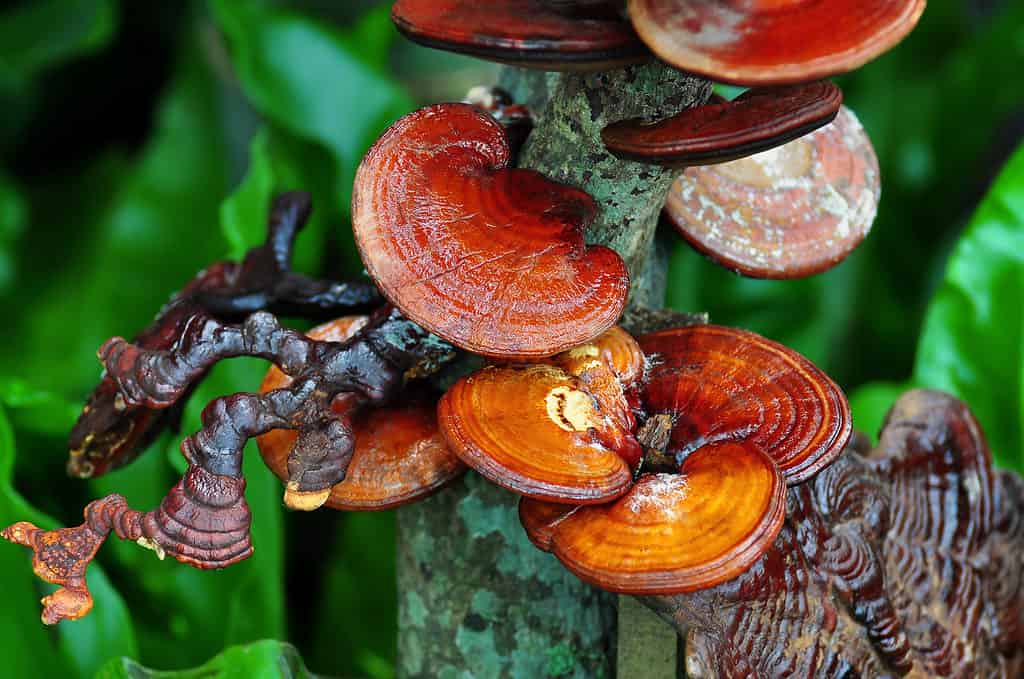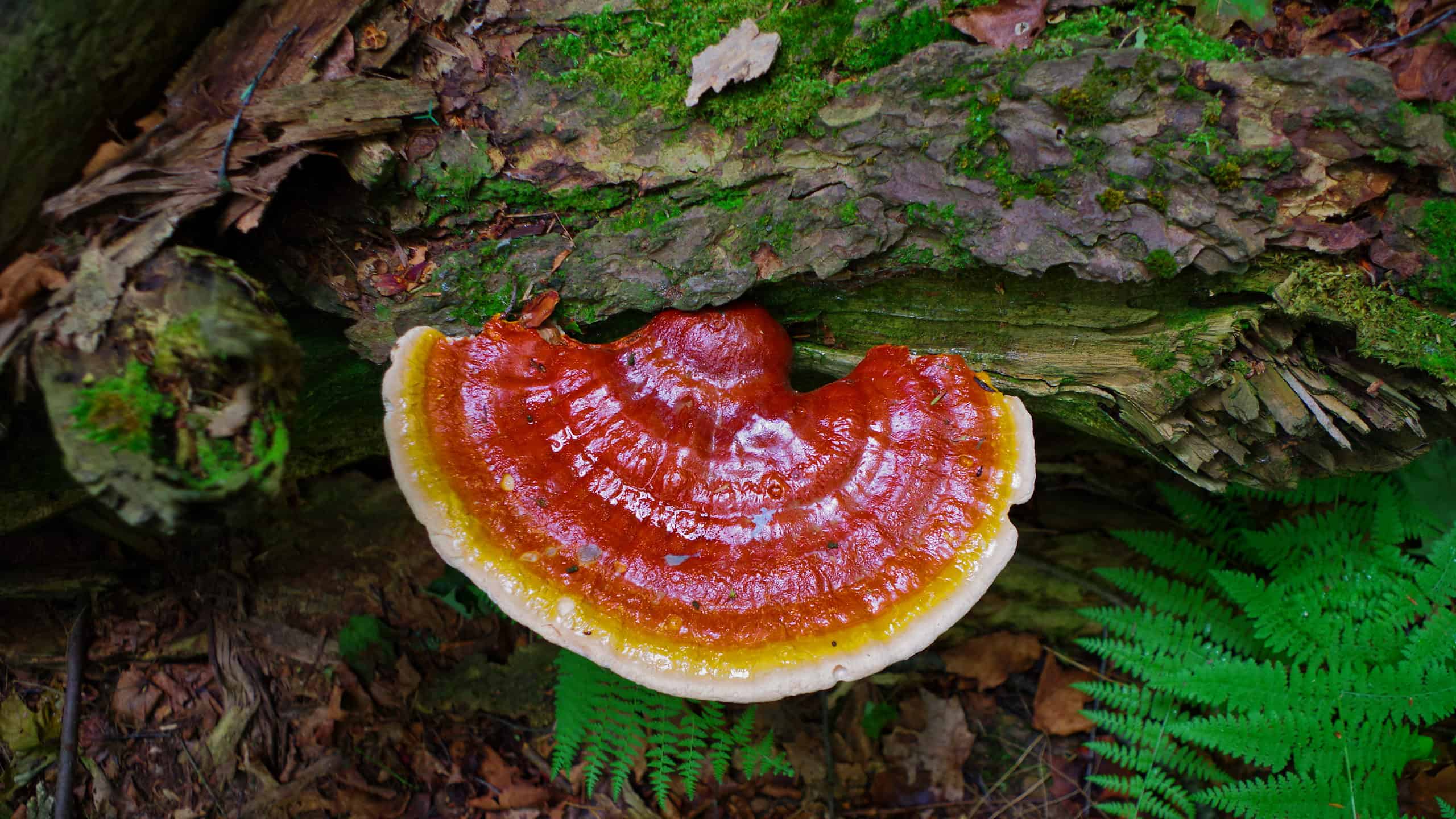When searching for a medicinal mushroom to grow yourself, reishi mushrooms are an option worth considering. They are notorious for their medicinal benefits and willingness to grow. In addition, their fruiting bodies are a sight to see. Furthermore, these mushrooms don’t need specialized equipment to grow, and there are various methods you can use, depending on your circumstances.
What Do Reishi Mushrooms Look Like?

Mature mushrooms flatten into a fan shape and have shiny, red bodies that fade to white, orange, or yellow towards the edge of the cap.
©iStock.com/ukjent
Reishi mushrooms grow horizontally on dead tree stumps, tree trunks, and in some cases, conifers. As it first starts to grow, slender stalks called antlers begin to appear. These finger-like stalks are generally rust-brown or red in color, with white, yellow, or tan borders. Mature mushrooms flatten into a fan shape and have shiny, red bodies that fade to white, orange, or yellow towards the edge of the cap. Unlike most mushrooms, there are pores, not gills, under the cap, containing brown spores that get released. It’s easy to distinguish between young and old reishi mushrooms as the younger specimens have a wet, lacquered look, while the older mushrooms have faded and turned a dull brown color.
Where Do Reishi Mushrooms Grow?
Reishi mushrooms grow worldwide because they can survive in several climates. For example, some species prefer tropical or subtropical weather, while others thrive in cooler temperatures. Additionally, these mushrooms like to inhabit decaying or dead hardwood trees like beech, maple, oak, or elm. However, some species prefer conifers, primarily hemlock. Furthermore, the position they grow on is a dead giveaway as reishi mushrooms typically grow closer to the ground at the base of stumps or trees. So, if you find something higher up, it’s probably not reishi mushrooms. Finally, the best time to find these mushrooms is from summer to fall. But older reishi occurs on trees throughout the year.
Reishi Mushrooms Health Benefits
These mushrooms have many health benefits and have been used in Asian medicine for centuries. It improves sleep, enhances the immune system, and fights fatigue. Many people also use it for:
- Cardiovascular disease
- High blood pressure
- Liver or kidney disease
- High cholesterol
- Asthma
- HIV/AIDS
- Viral Infections like the flu
- Cancer
- Enhancing stamina and strength
- Pain from a shingles outbreak
Growing Reishi Mushrooms at Home
There are two easy ways to grow reishi mushrooms. They include:
Fruiting Block
One of the easiest ways of growing reishi mushrooms is fruiting blocks similar to natural logs. You can obtain them from local suppliers in your area. They are made from sawdust and bran and typically start at five pounds. Then, they are sterilized and inseminated with grain spawn. Therefore, when preparing to plant the fruiting block, blend sawdust with the surrounding substrate. This increases the capacity to retain moisture.
Waiting For Results
It takes 20 days from the start of the spawn run to complete colonization. Soon, you will start to see finger-like antlers growing, which generally happens around day 28. Once these stalks grow one to three inches, the blocks are ready for planting. This means you can also remove the sawdust blocks from their container and plant them deep enough to keep them from floating in a pool of water. From this point, the reishi will form over 75 to 90 days, and if the growing season is long enough, you can expect a second flush over another 75 to 90 days.
Environment for Growth
You can use three methods to grow reishi mushrooms on the forest floor, in a greenhouse, or in a makeshift humid, and shady space. While using a greenhouse is more expensive than growing outdoors, the mushrooms in a greenhouse mature quicker.
Inoculating Logs With Sawdust Spawn
This process takes a bit longer as traditional methods of growing reishi mushrooms require inoculating logs with spores and fresh sawdust spawn. These logs need to incubate for nine months to a year before they are planted in the ground surrounded by shade or in a greenhouse in the early spring.
There are several benefits to growing these mushrooms like this, but the primary advantage is the production of higher-quality mushrooms, and you can expect two flushes over the season. Here is a step-by-step guide to inoculating logs with sawdust spawn:
1. Substrate Preparation
First, you have to select a healthy tree that’s relatively straight-limbed, like maple or oak. Then, fell the tree during fall or winter, right after the leaves turn brown or fall off. This is when the woods’ sugar and moisture content is the highest. Then, inoculate the wood within a month to ensure the moisture content is high and there is a decreased chance of other fungi getting to the log first.
2. Inoculation with Sawdust Spawn
You must take the sawdust spawn and inoculate the log by drilling one-inch holes into it. Next, spray some water into the holes for moisture and insert the sawdust spawn using a specialized tool called a palm tool until each crevice is full. Seal these holes with food-grade wax, which deters wildlife from feeding on them, or contamination from other fungi species.
3. Incubation
After inoculation, the incubation period begins, and it takes around 18 months. You need to store your log in a humid area like a greenhouse. The inoculated logs must not have any contact with the ground, so place them on clean pallets or something similar. When the mycelia appear on each end of the log, you can plant the logs, ensuring you dig deep enough to cover the blocks in a couple of inches of soil.
4. Maturation
Once pinning begins, the mushrooms will be ready to harvest in approximately three months. For example, they are ready once their white color turns red. When growing reishi mushrooms this way, they can harvest twice a season, generally from April to August.
The information presented on or through the Website is made available solely for general informational purposes. We do not warrant the accuracy, completeness, or usefulness of this information. Any reliance you place on such information is strictly at your own risk. We disclaim all liability and responsibility arising from any reliance placed on such materials by you or any other visitor to the Website, or by anyone who may be informed of any of its contents. None of the statements or claims on the Website should be taken as medical advice, health advice, or as confirmation that a plant, fungus, or other item is safe for consumption or will provide any health benefits. Anyone considering the health benefits of particular plant, fungus, or other item should first consult with a doctor or other medical professional. The statements made within this Website have not been evaluated by the Food and Drug Administration. These statements are not intended to diagnose, treat, cure or prevent any disease.
Thank you for reading! Have some feedback for us? Contact the AZ Animals editorial team.








